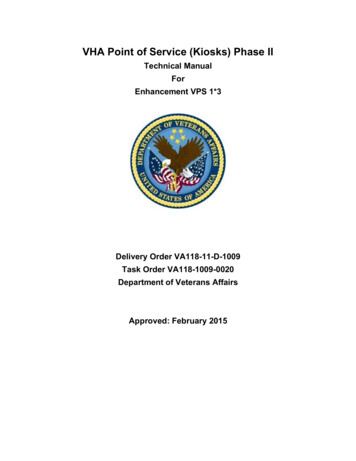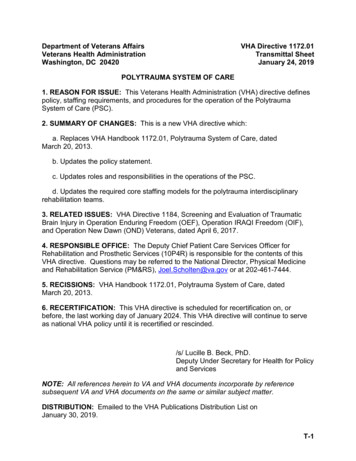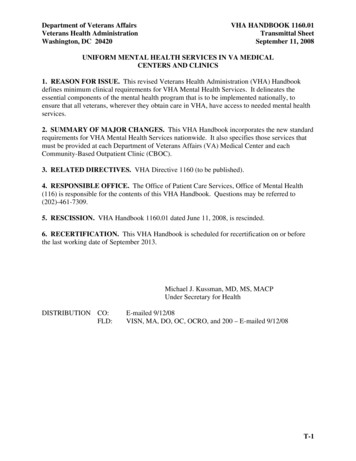
Transcription
VHA Point of Service (Kiosks) Phase IITechnical ManualForEnhancement VPS 1*3Delivery Order VA118-11-D-1009Task Order VA118-1009-0020Department of Veterans AffairsApproved: February 2015
Revision nitial draft.Add MRAR instance structureinformationMinor edits for typographical errors.(11/09/2015: Removed Harris Logo ManTech PMO Team)REDACTEDREDACTEDVPS 1*3 Technical ManualCreated: February 10, d: February 2015Version No. 0.03
Table of Contents1234567891011Orientation . 1How to Use this Manual . 1Intended Audience . 1Legal Requirements . 1Disclaimers. 1Documentation Conventions . 1Commonly Used Terms. 2Technical Information Online. 2Help Prompts . 2Data Dictionary . 3Assumptions. 3References . 3Introduction . 31.1 Product Overview. 31.2 Namespace Conventions . 4Implementation and Maintenance . 42.1 Site Parameters . 4Files . 43.1 VistA M Server Files . 43.2 MRAR Instance Structure . 6Global Translation, Journaling and Protection . 11Routines . 115.1 VPS 1*3 RPCs . 12Detailed VPS 1*3 RPC Information . 135.2 MRAR Patient Data Object and Health Summary Report . 135.2.1Insert VPS MRAR PDO into CPRS TIU Note . 135.2.2VPS MRAR Ad Hoc Health Summary . 17Archiving and Purging. 186.1 Archiving . 186.2 Purging . 18Callable Routines . 19External Interfaces . 19External Relations . 19Internal Relations . 19DBIA Agreements . 19VPS 1*3 Technical ManualCreated: February 10, 2015iiiRevised: February 2015Version No. 0.03
11.1 DBIA Agreements – Custodial Package . 1911.2 DBIA Agreements – Subscriber Package . 2012 Package-wide Variables . 2013 SAC Exemptions . 2014 Software Product Security . 2014.1 Security Management . 2014.2 Mail Groups and Alerts . 2014.3 Remote Systems. 2014.3.1 Connections . 2014.3.2 Remote Data Views . 2014.4 Interfaces . 2114.5 Electronic Signatures . 2114.6 Security Keys . 2114.7 File Security . 2214.8 Official Policies . 2215 Acronyms and Glossary . 2215.1 Acronyms . 2215.1.1 Glossary. 23FiguresNo table of figures entries found.TablesTable 1: Commonly Used VPS 1*3 Terms . 2Table 2 VPS 1*3 VistA M Server Files . 4Table 3 External Vista M Server Files Asccessed by VPS 1*3 . 6Table 4 VPS1*3 VistA Routines . 11Table 5 VPS 1*3 RPCs - Tags and Routines . 12Table 6 VPS 1*3 File Security . 22Table 7: List of Acronyms . 22Table 8: Glossary. 23VPS 1*3 Technical ManualCreated: February 10, 2015ivRevised: February 2015Version No. 0.03
OrientationHow to Use this ManualThis manual provides instructions on the use of VPS 1*3 remote procedure calls (RPCs) to accessVeterans Health Information Systems and Technology Architecture (VistA) as a data source for VHAPoint of Service (Kiosks).Intended AudienceThe intended audience of this manual is the following stakeholders: Product Development (PD) VistA legacy development teams. Information Resource Management (IRM) system administrators at Department of VeteransAffairs (VA) sites who are responsible for computer management and system security on VistAM Servers. Information Security Officers (ISOs) at VA sites responsible for system security. Health Product Support (HPS) Information Technology (IT) Specialists who provide applicationsupport to VA end-users.Legal RequirementsThere are no special legal requirements involved in the use of VPS 1*3 RPCs.DisclaimersThis manual provides an overall explanation of VPS 1*3 functionality. This guide does not attempt toexplain how the overall VistA programming system is integrated and maintained.DISCLAIMER: The appearance of any external hyperlink references in this manual does notconstitute endorsement by the Department of Veterans Affairs (VA) of this Website or theinformation, products, or services contained therein. The VA does not exercise anyeditorial control over the information you may find at these locations. Such links areprovided and are consistent with the stated purpose of this VA Intranet Service.Documentation ConventionsThe following symbols are used throughout this document to alert the reader to special information.NOTE/REF: Used to denote general information including references to additionalreading material.CAUTION / RECOMMENDATION / DISCLAIMER: Used to caution the reader totake special notice of critical information.VPS 1*3 Technical ManualCreated: February 10, 20151Revised: February 2015Version No. 0.03
Snapshots of computer online displays (screen captures) and computer source code are shown innon-proportional font and are enclosed within a box. User responses to displayed prompts are bolditalic typeface. Software reserved words are displayed in bold font.References to “ Enter ” within the screen captures indicate that the user should press the Enter key on the keyboard. Other special keys are represented within angle brackets and indicate theuser should press the indicated key on the keyboard. For example, PF1 directs the user to pressthe PF1 key on the keyboard.The following conventions are used to display test data: Social Security Numbers (SSN) for test patients are prefixed with five zero digits e.g.000009999. Patient names are formatted as [Application Name]PATIENT,[N] e.g. VPSPATIENT,ONE. User names are formatted as [Application Name]USER[N] e.g. VPSUSER, ONE.This guide refers to the M programming language as M. Under the 1995 AmericanNational Standards Institute (ANSI) standard, M is the primary name of the MUMPS programminglanguage, and MUMPS is considered an alternate name.Commonly Used TermsTable 1: Commonly Used VPS 1*3 TermsTermDescriptionClientA single term used interchangeably to refer to a user, the workstation (i.e.,PC), and the portion of the program that runs on the workstation.ComponentA software object that contains data and code. A component may or may notbe visible.GUIThe Graphical User Interface application that is developed for the clientworkstation.HostThe term Host is used interchangeably with the term Server.ServerThe computer where the data and the RPC Broker remote procedure calls(RPCs) reside.Technical Information OnlineProject documentation for VPS Kiosks may be found in the Technical Services Project Repository(TSPR). Other online technical information from M Server-based software file, routine and globaldocumentation may be generated using Kernel, MailMan and VA FileMan utilities.Help PromptsThere are no online help prompts provided for VPS 1*3.VPS 1*3 Technical ManualCreated: February 10, 20152Revised: February 2015Version No. 0.03
Data DictionaryTechnical information on VistA M Server-based files is stored in the VA FileMan Data Dictionary. TheVA FileMan List File Attributes option on the Data Dictionary Utilities submenu may be used to view theattributes of VistA M Server files.AssumptionsThis guide is written with the assumption that the reader is familiar with: Kernel – VistA M Server software Remote Procedure Call (RPC) Broker – VistA Client/Server software VA FileMan data structures and terminology – VistA M Server software Microsoft Windows M programming languageReferencesThe following references support the reader’s understanding of the operation and functioning of VPS 1*3: VPS 1-3 Technical Manual (this guide)RPC Broker Release NotesRPC Broker Developer’s GuideRPC Broker Systems Management GuideRPC Broker TCP/IP Supplement, Patch XWB*1.1*35 and XWB*1.1*44RPC Broker Technical ManualRPC Broker User GuideVeteran’s Point of Service (VPS) FY14 OIT PD BRD, Version 2.0 (May 2014)20090210 VHA Point-of-Service Initiative BRDHealth Summary User Manual, Version 2.7 (August 2014)Text Integration Utilities (TIU) Technical Manual, TIU*1*263 (Jun3 2014)These references may be downloaded from the VA Software Document Library (VDL) Website.1 IntroductionThe VPS 1*3 Technical Manual provides descriptive information and instruction on the use of VPS 1*3Remote Procedure Calls (RPCs) within VA's Veterans Health Information Systems and TechnologyArchitecture (VistA) environment. This document is intended for systems managers—InformationResource Management (IRM) personnel who are responsible for implementing and maintaining thissoftware, application programmers, and developers. It acquaints system managers with the softwarestructure and functionality of the VPS RPC routines and files that comprise this software.1.1 Product OverviewVPS 1*3 provides RPCs that interface VetLink with VAs Medication Review and Allergy Review(MRAR) process and supports the VA National Medication Reconciliation Directive. VPS 1*3 RPCsprovide real-time storage of patient self-reported medication and allergy data entered at the Kiosk toVPS 1*3 Technical ManualCreated: February 10, 20153Revised: February 2015Version No. 0.03
VistA VPS MRAR data files. Additionally, VPS 1*3 returns this collected MRAR data to VetLink toallow clinic staff and clinicians to view, update and verify the patient’s self-reported MRAR data.In addition, VPS 1*3 provides the RPCs to support MRAR statistical analysis to report on the timerequired to complete patient MRAR reviews, reasons for incomplete reviews, and other clinic efficientuse variables. VPS 1*3 also provides the capability for Veteran Affair Medical Center (VAMC) ClinicalCoordinators to create MRAR patient data objects (PDOs) that may be embedded into Text IntegrationUtilities (TIU) notes.1.2 Namespace ConventionsVPS is the namespace assigned to VPS 1*3.2 Implementation and MaintenanceThe VPS 1*3 Installation Manual provides detailed information regarding the installation of VPS*1.0*3.2.1 Site ParametersNo site specific parameters are provided or required for VPS 1*3.3 Files3.1 VistA M Server FilesVPS 1*3 reads data from and writes data to VistA M Server files owned and maintained by VPS. Thefollowing table lists the VistA M Server VPS files and global references used by VPS 1*3 RPCs.Table 2 VPS 1*3 VistA M Server FilesFILE NAME ANDNUMBERGLOBALREFERENCEVPS ALLERGYDISCREPANCYINDICATORS #853.3 VPS(853.3VPS CONFIG HISTORY#853 VPS(853VPS 1*3 Technical ManualCreated: February 10, 2015SUMMARY DESCRIPTIONThis file contains a list of the various indicatorsthat Vecna will send to VistA for the capture ofdiscrepancies between patient reported allergiesand the allergy data on file for the patient. Afundamental objective of MRAR is to identifyallergy data omissions and medication adherencediscrepancies. The Kiosk (patient facing) and thestaff-facing interface allows a veteran, staff, orprovider to change an allergy status (e.g., allergicto non-allergic).This file stores all the changes made to a Kiosk'sconfiguration parameters and facilitates aggregatebusiness intelligence. The current values of Kiosk'sparameters are stored in Vetlink's KIOSKdatabase. The business and administrativeparameters are used to configure and direct MRAR4Revised: February 2015Version No. 0.03
FILE NAME ANDNUMBERGLOBALREFERENCEVPS MED DISCREPANCYINDICATORS #853.7 VPS(853.7VPS MRAR PDO #853.5 VPS(853.5SUMMARY DESCRIPTIONbehavior amongst the Vetlink KIOSK groups orClinics. Data in this file is populated via RPCcall(s) made by the Vetlink client.This file contains a list of the various indicatorsthat Vetlink will send to VistA for the accuratecapture of medication discrepancies betweenpatient report medications and medication data onfile for the patient. A fundamental objective ofMRAR is to identify allergy data omissions andmedication adherence discrepancies. The Kiosk(patient facing) and the staff-facing interfaceallows a veteran, staff, or provider to change amedication status (e.g. from 'NO, not taking' to'Yes, taking as written').This file stores patient MRAR data for the (VPS)kiosk application. Data is stored to the files usingVPS remote procedure calls that are invoked by theVetlink Kiosk (patient-facing) or staff-facing clientinterface. Each patient MRAR review is saved byVetlink and then sent to VistA, using RPC Broker,for storage.The data stored in this file is sorted by PATIENTwhere each patient entry has one or moreMedication Review Allergy Review (MRAR)session instances and these MRAR instances aresorted by transaction date/time. Each sessionrepresents a complete or incomplete MRAR.VPS 1*3 Technical ManualCreated: February 10, 20155Revised: February 2015Version No. 0.03
In addition to VistA M Server files in the VPS namespace, VPS 1*3 reads data from files in the externalnamespaces shown in the following table.Table 3 External Vista M Server Files Accessed by VPS 1*3FILE NAME AND NUMBERPATIENT ALLERGIES FILEGLOBAL REFERENCE GMR(120.83.2 MRAR Instance StructureThe central structure in the VPS MRAR PDO file #853.5 is the MRAR instance sub-file #853.51. Apatient may have multiple instances of MRAR sessions. The data collected in MRAR session is stored inan instance structure. Edits to the MRAR instance should not be made in FileMan. All edits andupdates to an MRAR instance should be made through VetLink or the staff-facing Kiosk application.The overall structure of an MRAR instance consists of 5 primary nodes. Sub-nodes (files) of eachprimary node are shown indented under their parent node.853.51 MRAR instance fields853.8121 MRAR CONDUCTED WITH853.52 ALLERGIES853.57 REACTIONS853.58 ALLERGY COMMENTS PATIENT853.56 ALLERGY COMMENTS STAFF VIEW853.523 ALLERGY COMMENTS VET VIEW853.525 ALLERGY CHANGED INDICATORS853.526 ALLERGY CONFIRMED INDICATORS853.527 ALLERGY DISCREPANCY INDICATORS853.53 ADDITIONAL ALLERGIES853.531 ADD ALLERGY VET853.59 ADD ALLERGY PROVIDER853.54 MEDICATIONS853.5423 MEDICATION COMMENTS PATIENT853.5424 MEDICATION COMMENTS STAFF853.5425 MEDICATION COMMENTS VET VIEW853.5452 MED DISCREPANCY INDICATORS853.5454 MED CHANGED INDICATORS853.5455 MED CONFIRMED INDICATORSVPS 1*3 Technical ManualCreated: February 10, 20156Revised: February 2015Version No. 0.03
853.55 ADDITIONAL MEDICATIONS853.557 ADD MED COMMENTS-STAFF VIEW853.5512 ADD MED COMMENTS-VET VIEW (Multiple-853.5512), [AMCOMM2;0]VPS 1*3 Technical ManualCreated: February 10, 20157Revised: February 2015Version No. 0.03
The following table shows the complete structure of a VPS MRAR PDO 91011121314151617181920212223242526272829FIELD NAME, GLOBAL LOCATIONTRXN DATE/TIME (RDX), [0;1]DEVICE ID (F), [0;2]KIOSK GROUP (F), [0;3]ENCOUNTER CLINIC (P44'), [0;4]APPT DATE/TIME (D), [0;5]PROVIDER (P200'), [0;6]MRAR SESSION ID (NJ10,0), [0;11]INTERFACE MODULE (S), [0;12]AR INITIATED DT (D), [1;1]AR COMPLETED DT (D), [1;2]AR INCOMPLETE DT (D), [1;5]AR INCOMPLETE REASON TYPE (S), [1;6]AR SESSION OUTCOME (S), [1;7]ADD ALLERGY INITIATED DT (D), [2;3]ADD ALLERGY COMPLETED DT (D), [2;4]ALLER CHANGE COMPLETED DT (D), [1;8]ALLER CHANGE INITIATED DT (D), [1;9]AR FREE TEXT USED (S), [1;12]AR FREE TEXT COMPLETED DT (D), [1;13]VET VIEW ADD ALLERGY COMP DT (D), [1;14]VET VIEW ADD ALLER INIT DT (D), [1;15]VET VIEW CHANGE ALLER COMP DT (D), [1;16]VET VIEW CHANGE ALLER INIT DT (D), [1;17]MR CHANGE REASON INITIATED DT (D), [5;14]OTH ALLERGY UNK PATIENT (S), [2;1]NO KNOWN DRUG ALLERGIES (S), [2;2]MRAR CONDUCTED WITH (Multiple-853.5121), [MRARWITH;0].01 MRAR CONDUCTED WITH (S), [0;1]MR MULTIPLE SESSIONS (S), [5;3]MR FREE TEXT USED (S), [5;15]VET VIEW CHG DOD MED COMP DT (D), [6;1]VET VIEW CHG DOD MED INIT DT (D), [6;2]VET VIEW CHG NONVA MED COMP DT (D), [6;3]VET VIEW CHG NONVA MED INIT DT (D), [6;4]VET VIEW CHG LOCAL MED COMP DT (D), [6;5]VET VIEW CHG LOCAL MED INIT DT (D), [6;6]VPS 1*3 Technical ManualCreated: February 10, 20158Revised: February 2015Version No. 0.03
3031323340ALLERGIES (Multiple-853.52), [ALLERGY;0].01 ALLERGY ENTRY # (NJ10,0X), [0;1].02 LOCAL ALLERGY ID (P120.8'), [0;2].03 REMOTE ALLERGY ID (NJ10,0), [0;3].05 REMOTE ALLERGY NAME (F), [0;5].06 AR PATIENT RESPONSE (S), [0;6].07 REACTIONS (Multiple-853.57), [REACTIONS;0].01 REACTION ENTRY # (NJ10,0), [0;1].02 LOCAL REACTION ID (P120.83'), [0;2].03 REMOTE REACTION ID (NJ10,0), [0;3].04 REMOTE REACTION NAME (F), [0;4].09 REMOTE FACILITY (P4'), [0;8]1ALLERGY COMMENTS PATIENT (Multiple-853.58), [ACOMM1;0].01 ALLERGY COMMENTS PATIENT (W), [0;1]2ALLERGY COMMENTS STAFF VIEW (Multiple-853.56), [ACOMM2;0].01 ALLERGY COMMENTS STAFF VIEW (Wx), [0;1]3ALLERGY COMMENTS VET VIEW (Multiple-853.523), [ACOMM3;0].01 ALLERGY COMMENTS VET VIEW (Wx), [0;1]4ALLERGY DOD (S), [0;7]5ALLERGY CHANGED INDICATORS (Multiple-853.525), [ACHG;0].01 ALLERGY CHANGED (P853.3'), [0;1]6ALLERGY CONFIRMED INDICATORS (Multiple-853.526), [ACNFR;0].01 ALLERGY CONFIRMED (P853.3'), [0;1]7ALLERGY DISCREPANCY INDICATORS (Multiple-853.527), [ADISCR;0].01 ALLERGY DISCREPANCY (P853.3'), [0;1]12ALLERGY CHANGED (P853.3'), [0;22]13ALLERGY CONFIRMED (P853.3'), [0;23]14ALLERGY DISCREPANCY (P853.3'), [0;24]16ALLERGY-MARK FOR FOLLOWUP (S), [0;26]VET VIEW CHG REMOT MED COMP DT (D), [6;7]VET VIEW CHG REMOT MED INIT DT (D), [6;8]WEB ID (F), [7;1]ADDITIONAL ALLERGIES (Multiple-853.53), [ALLERGYADD;0].01 ADDITIONAL ALLERGIES ENTRY # (MNJ10,0), [0;1]1ADD ALLERGY-VET (Multiple-853.531), [1;0].01 ADD ALLERGY-VET (Wx), [0;1]1.5 ADD ALLERGY-PROVIDER (Multiple-853.59), [2;0].01 ADD ALLERGY-PROVIDER (Wx), [0;1]2ADD ALLERGY REACTION (STAFF) (F), [0;3]3ADD ALLERGY ADDED BY (S), [0;4]4ADD ALLERGY-MARK FOR FOLLOWUP (S), [0;5]5ADD ALLERGY NOT KNOWN (S), [0;2]VPS 1*3 Technical ManualCreated: February 10, 20159Revised: February 2015Version No. 0.03
50MEDICATIONS (Multiple-853.54), [MEDS;0].01 MEDICATION ENTRY # (NJ10,0X), [0;1]1PRESCRIPTION ID (NJ10,0), [0;2]2PROVIDER NAME (F), [0;3]3FILL LOCATION (P4'), [0;4]4LAST FILL DATE (D), [0;5]5DAYS SUPPLIED (NJ3,0), [0;6]6# REFILLS LEFT (NJ2,0), [0;7]7NEXT FILL DATE (D), [0;8]8MED EXPIRE DATE (D), [0;9]9MED ID (NJ10,0), [0;10]10MEDICATION NAME (F), [0;11]11MR PRESET PATIENT RESPONSE (S), [0;12]12RX STATUS (S), [0;13]13MED SIG (F), [SIG;1]14MED DOSAGE (F), [0;14]15MED DOSAGE FORM (F), [0;15]16MEDS-MARK FOR FOLLOWUP (S), [0;16]17MED ROUTE (F), [0;17]18MED IMAGE INDICATOR (S), [0;18]19MED FINISHING PERSON (F), [2;1]20NATIONAL DRUG SID (F), [3;1]21NON-VA (S), [0;21]22MAX REFILLS (NJ2,0), [0;22]23MEDICATION COMMENTS PATIENT (Multiple-853.5423), [MEDCOM;0].01 MEDICATION COMMENTS PATIENT (Wx), [0;1]24MEDICATION COMMENTS STAFF VIEW (Multiple-53.5424),[MEDCOM2;0].01 MEDICATION COMMENTS STAFF VIEW (Wx), [0;1]25MEDICATION COMMENTS VET VIEW (Multiple-853.5425), [MEDCOM3;0]01 MEDICATION COMMENTS VET VIEW (Wx), [0;1]26RX PATIENT STATUS (F), [2;2]27RX NUMBER (NJ9,0), [0;19]28RX OUTPATIENT ID (NJ9,0), [0;20]29RX SC FLAG (S), [2;3]30MEDICATION DISCREPANCY (P853.7'), [1;1]31MEDICATION CHANGED (P853.7'), [1;2]32MEDICATION CONFIRMED (P853.7'), [1;3]33CANCEL DT (D), [2;4]34CMOP STATUS (S), [2;5]35COUNSELED FLAG (S), [2;6]36COUNSELING UNDERSTOOD FLAG (S), [2;7]37DIVISION SID (F), [4;1]38ENTERED BY (F), [4;2]39MED ISSUE DT (D), [4;3]40COPAY TRANSACTION (F), [5;1]41EBILL ACTION NUMBER (NJ9,0), [5;2]42ETL BATCH ID FAILURE (NJ9,0), [5;3]43RELEASE DT (D), [2;8]44QUANTITY SUPPLIED (NJ12,2), [2;9]45MED REMOTE (S), [3;2]46REMOTE MED FACILITY (F), [3;3]47DRUG NAME W/O DOSE (F), [2;10]48HIGH RISK MED CLASS (F), [6;1]49HIGH RISK MED NAME (F), [6;2]50HIGH RISK MED YEAR (NJ4,0), [6;3]51MED IMAGE (S), [6;4]VPS 1*3 Technical ManualRevised: February 201552 10, MEDCreated: February2015 DISCREPANCY INDICATORS10 (Multiple-853.5452), [MDISCR;0]Version No. 0.03.01 MED DISCREPANCY (P853.7'), [0;1]53MED CHANGED INDICATORS (Multiple-853.5454), [MCHG;0].01 MED CHANGED (P853.7'), [0;1]
60ADDITIONAL MEDICATIONS (Multiple-853.55), [MEDSADD;0].01 ADDITIONAL MEDICATIONS ENTRY # (MNJ10,0), [0;1]1PATIENT-FACING ADD MEDICATION (F), [0;2]2STAFF VIEW ADD MEDICATION (F), [1;1]3VET VIEW ADD MEDICATION (F), [1;2]4VET PLANS TO DISCUSS ADD MED (S), [1;3]5ADD MED FREQUENCY (PATIENT) (S), [0;3]6ADD MED DIRECTIONS (PATIENT) (F), [0;4]7ADD MED COMMENTS-STAFF VIEW (Multiple-853.557), [AMCOMM;0].01 ADD MED COMMENTS-STAFF VIEW (Wx), [0;1]8ADD MED DOSE (STAFF) (F), [1;4]9ADD MEDS-MARK FOR FOLLOW-UP (S), [1;5]10ADD MED INDICATION (STAFF) (F), [2;1]11ADD MED TIME (PATIENT) (S), [0;5]12ADD MED COMMENTS-VET VIEW (Multiple-853.5512), [AMCOMM2;0].01 ADD MED COMMENTS-VET VIEW (Wx), O FIRST INVOKED DT (D), [4;1]PDO INVOCATION ERROR (S), [4;3]PDO NEXT INVOKED DT (D), [4;4]STAFF MODULE COMPLETED DT (D), [4;5]STAFF MODULE SIGNED DT (D), [4;7]MR INITIATED DT (D), [5;1]MR COMPLETED DT (D), [5;2]MR CHANGE MED INITIATED DT (D), [5;4]MR CHANGE MED COMPLETED DT (D), [5;5]MR CHANGE REASON COMPLETED DT (D), [5;6]MR INCOMPLETE REASON TYPE (S), [5;7]MR FREE TEXT SECTION DONE DT (D), [5;8]MR SESSION OUTCOME (S), [5;9]MR ADD MED INITIATED DT (D), [5;10]MR ADD MED COMPLETED DT (D), [5;11]VET VIEW ADD MED INITIATED DT (D), [5;12]VET VIEW ADD MED COMPLETED DT (D), [5;13]VET VIEW CHG ALL MED INIT DT (D), [5;16]VET VIEW CHG ALL MED COMP DT (D), [5;17]MR INCOMPLETE DT (D), [5;19]TIU NOTE (P8925'), [4;8]4 Global Translation, Journaling and ProtectionJournaling, global translation and protection of VistA M Server files for which VPS 1*3 is the custodialowner is provided by nightly extracts to the Corporate Data Warehouse (CDW).5 RoutinesTable 4 VPS1*3 VistA RoutinesROUTINE NAMEVPSMRAR1VPS 1*3 Technical ManualCreated: February 10, 2015DESCRIPTIONProcedures and function calls to store patient’s MRAR instance data11Revised: February 2015Version No. 0.03
ROUTINE NAMEDESCRIPTIONvalues and create the patient’s MRAR PDO.VPSMRAR2Procedures and functions to store a patient’s allergy data to VPSMRAR files.VPSMRAR3Procedure and functions to store a patient’s additional allergy data toVPS MRAR files.VPSMRAR4Procedures and functions to store a patient’s medication data to VPSMRAR files.VPSMRAR5Procedures and functions to store a patient’s additional medicationdata to VPS MRAR files.VPSMRAR7Procedures and functions to store a patient’s allergy reaction data toVPS MRAR files.VPSMRAR9Procedures and function to read an identified patient’s MRARclinical data.VPSPDO1Procedures and function calls to read a patient’s MRAR clinical datato provide PDO output.VPSMRARUProcedures and functions to update an identified patient’s mostrecent MRAR clinical data with the applicable TIU documentinternal entry number (IEN).VPSPARAMProcedures and functions to store outpatient clinic kioskconfiguration parameters used to define clinic kiosk functionalityand devices.5.1 VPS 1*3 RPCsThe VPS 1*3 routines are executed by remote procedure calls through VistA RPC Broker. The followingtable lists the VPS 1*3 RPCs giving the RPC tag and routine name used for invocationTable 5 VPS 1*3 RPCs - Tags and RoutinesRPC NAMETAGROUTINEVPS WRITE MRAR PDOWRITEVPSMRAR1VPS WRITE KIOSK PARAMETERSWRITEVPSPARAMVPS GET MRAR PDOGETVPSPDO1VPS GET LAST MRARGETVPSMRAR9VPS UPDATE LAST MRAR TIU IENUPDATEVPSMRAR3VPS 1*3 Technical ManualCreated: February 10, 201512Revised: February 2015Version No. 0.03
Detailed VPS 1*3 RPC InformationDetails on the input parameters and the output produced by each of the VPS 1*3 RPCs may be obtainedfrom a FileMan inquiry to the REMOTE PROCEDURE file # 8994.5.2 MRAR Patient Data Object and Health Summary ReportA patient data object (PDO) is dynamically created and available in the Computerized Patient RecordSystem (CPRS). VPS*1*3 provides a TIU Document Definition for the VPS MRAR PDO object. Thisobject when accessed invokes the TIU VPSPDO1 M (MUMPS) run routine passing in the patient’sidentifier. The VPS M language run routine VPSPDO1 routine reads the VPS MRAR PDO file to createthe MRAR PDO object.5.2.1 Insert VPS MRAR PDO into CPRS TIU NoteTo insert the patient’s VPS MRAR PDO object into a CPRS Note, create or edit a TIU template.1. Select a patient in CPRS.2. Click the Notes tab.3. Click the Template dropdown list:4. Right-click in the Template window and select Create New Template entry.VPS 1*3 Technical ManualCreated: February 10, 201513Revised: February 2015Version No. 0.03
5. In the top section of the Template Editor window, enter a name for the template e.g., MY VPSMRAR PDO TEMPLATE. Click the OK button.VPS 1*3 Technical ManualCreated: February 10, 201514Revised: February 2015Version No. 0.03
6. A personal template folder is created with a blank MyVPS MRAR PDO TEMPLATE.as shownin the following screen capture.REDACTED7. Right-click the “My VPS MRAR PDO TEMPLATE and select “Edit Template” from the list.8. In the lower portion of the Template Editor, enter text to be included in the template.9. Click the Edit menu item and select Insert Patient Data (Object).10. Choose VPS Mrar PDO from the list.VPS 1*3 Technical ManualCreated: February 10, 201515Revised: February 2015Version No. 0.03
The reference to the VPS MRAR PDO will appear at the current cursor location in th
02/10/2015 0.01 Initial draft. REDACTED 02/26/2015 0.02 Add MRAR instance structure information REDACTED 3/16/2015 0.03 Minor edits for typographical errors. (11/09/2015










